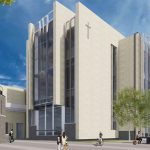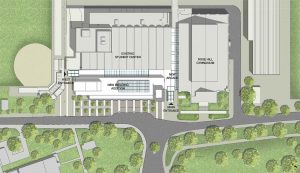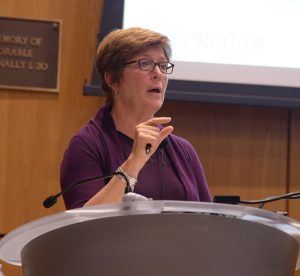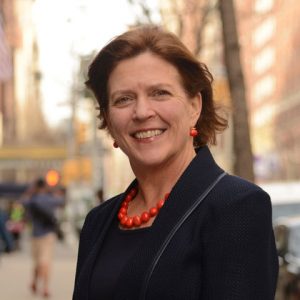Over the past three fiscal years, Fordham has navigated the pandemic through significant reduction measures and an infusion of federal relief funds. Last year, thanks to higher-than-anticipated revenue—in large part due to the biggest first-year class in University history—and continued federal funding, the University found itself on stable footing. Now, with less than two months left in the fiscal year, the University continues to be in a good position, said Martha K. Hirst, senior vice president, chief financial officer, and treasurer of Fordham, at the Spring 2022 Budget Forum on May 13.
“We’ve come through fiscal year 22 really quite well—aided by a waning pandemic, but really aided by careful budget management and forecasting on the part of the finance team and all the budget managers across the University,” Hirst said. “I’m extremely grateful to them all.”
Reflections on the Past Year
In a Zoom presentation, Hirst and Nicholas Milowski, vice president for finance and assistant treasurer, offered final conclusions on the fiscal year budget that ends this June.
Total net tuition and revenue grew beyond what the finance team had budgeted, thanks to the larger-than-average number of students that arrived at Fordham last fall, said Hirst. The fiscal year budget also benefited from federal COVID-19 relief, higher graduate school tuition and fees—specifically in the Gabelli School of Business and the Graduate School of Social Service, lower undergraduate discount rates, and lower health insurance premiums, she said.
“This budget was built on a series of reductions in expenses that enabled us to stabilize the budget and have in-person classes and students in dorms and on our campuses in ways that we haven’t been able to experience in the prior two years. We end this year with a positive operating result that is $3.2 million,” said Hirst. “It’s not a very big number when you think about us being a half-a-billion dollar enterprise.”
A New Budgeting System
The fiscal year budget that begins this July will be unlike any other budget in Fordham’s history, said Hirst and Milowski. This new system—an all-funds budget, which the finance team has been building for more than three years—will include funds that haven’t been historically included in the operating budget. The all-funds budget will incorporate direct donor contributions and government grants in addition to the traditional operating budget. In other words, it will reflect all sources and uses of the University’s resources, said Hirst.
“Direct contributions and grants are important revenue sources for us. They’re not huge, but they’re critical, and acknowledging them in our operating budget going forward will show our complete financial picture and allow for appropriate budgeting controls to be in place in those areas,” Hirst said.
The Impact of Inflation on Student Tuition
One of the most critical drivers in the upcoming budget is inflation, which has been driving significant increases in tuition rates across the country, said Milowski.
Next year, Fordham will have an undergraduate tuition rate increase of 4%. Milowski said this is significantly lower than the most recent consumer price index, a widely used measure of inflation, which rose to 8.3% in April. Milowski pointed out that in the prior academic year, there was no increase in undergraduate tuition rate. He also noted that the difference between “sticker price” and net revenue per undergraduate full-time equivalent student shows that students save a significant amount of money through financial aid.
“We’re giving most first-year incoming undergraduate students a 50% reduction off of their sticker price,” Milowski said. “We believe it to be very important for our mission, and we always wish that we can do more. But as Martha pointed out, there are so many pressures that are pushing us in different directions, that this is the place where we believe we can arrive at in a financially responsible way.”
Combating Inflation by Increasing ‘Special Endowment Payout’
Next year, Fordham will also withdraw nearly $6 million from the portion of the endowment that supports the operating budget in order to close a substantial gap between anticipated revenues and expenses.
While crafting the annual budget, the University worked to close a $30 million gap between anticipated revenues and expenses through multiple actions, including refining enrollment and financial aid projections as well as increasing unrestricted fundraising. These efforts brought the budget 80% of the way toward closing the gap. The “special endowment payout,” will close that final gap, said Hirst.
Hirst added that this is a temporary measure and an unusual step, but one that reflects the reality of today’s world.
“In a year when we lose the federal funds we’ve been relying on and when inflation is climbing as it is, those funds from the endowment became necessary,” Hirst said.
Maintaining an Affordable Education for Students
In conclusion, the fiscal year 23 all-funds budget proposes total revenues of $698.2 and total expenses of $698.2, said Fordham’s finance team. The principal drivers of revenue are forecasted to be the net undergraduate tuition revenue increase of $7.4 million, as well as an expectation of full housing occupancy, resulting in $11.3 million. The principal drivers of expense increases are salaries and benefits, the additional costs associated with operating the new campus center totaling $9.3 million, and a larger-than-normal increase in general expenses in anticipation of high inflation. In addition, the budget has a built-in inflation factor and a contingency budget of $5 million, which can aid in unanticipated expenses, said Hirst.
The budget is developed to manage the University’s financial resources so as to maximize their use and ensure we are investing them in the best ways to deliver on the promise of a Fordham education, said Hirst, while at the same time seeking to keep that first-rate educational experience as affordable as possible to students and their families.
“We’re Fordham University,” said Hirst. “We’re not going to do more in that regard than we absolutely have to, to be able to maintain the institution and grow in positive ways.”
A full recording of the Spring 2022 Budget Forum is below:
]]>“Moody’s and S&P provided similar commentary, praising the University’s strong financial management during the COVID-19 pandemic and, just as importantly, our ability to bounce back with not only record enrollments, but record fundraising during such a turbulent and uncertain time,” said Martha K. Hirst, senior vice president, chief financial officer, and treasurer of Fordham. “The fact that there were no surprises in the rating agencies’ reports assures us that we have a good pulse on our operating environment, risks, and opportunities for Fordham.”
The nearly $114 million bond transaction with the Dormitory Authority of the State of New York, which began in early September and reached completion in mid-November, is one of the fastest-paced transactions that Fordham’s finance team has completed. Thanks to the transaction, the University was able to refinance $91 million, allowing it to borrow an extra $20 million at no additional cost to the University’s operating budget.
“The opportunity for us in this bonds transaction was twofold,” said Nicholas Milowski, vice president for finance and assistant treasurer. “First, we took advantage of low interest rates before the Federal Reserve began to taper the pace of its bond purchases. Second, we were able to showcase how strong the University has emerged from the pandemic financially. In order to stay open, many colleges and universities were forced to sell part of their endowment, merge with other institutions, incur more debt, or lay off or furlough their employees—but not us. We are in a relatively strong place.”
Moody’s and S&P’s credit ratings reports spotlighted several strong points about Fordham. Both reports applauded Fordham’s ability to manage its finances during the pandemic, which was also highlighted at the 2021 spring budget forum. In addition, they emphasized the University’s consistent operating performance, solid management, conservative budgeting practices, and growing enrollment numbers, especially in the Class of 2025.
“Enrollment continues to rise with the exception of a coronavirus related dip in fall 2020 and supports prospects for rising net tuition revenue. That revenue growth along with strong fundraising is boosting operating performance and building reserves,” read the Moody’s report.
To improve its credit rating, the University should increase its growth in financial reserves to offset future debt and operations expenses, said the reports. But overall, the reports signify a stable outlook for Fordham.
“We are pleased that the credit rating agencies recognize Fordham’s financial stability, especially during this period of volatility and uncertainty,” said Hirst. “Enhancing the Fordham experience for our students requires a strong financial position, and we fully intend to continue to exercise discretion in how we manage Fordham’s limited resources.”
]]>“We’ve navigated a path through the woods, but we are not out of the woods yet,” Martha K. Hirst, senior vice president, chief financial officer, and treasurer, told more than 300 members of the University community over Zoom.
No Employee Furloughs or Layoffs
At the beginning of the pandemic, Fordham quickly pivoted from its original plans for the 2021 fiscal year and explored more than 15 possible scenarios based on two critical factors—loss of revenue from enrollment and on-campus student housing. The University ultimately managed more than $100 million in revenue loss and expense reductions through a series of budget actions, including a hiring and salary freeze and a temporary suspension of retirement match contributions for employees, said Hirst. But Fordham did not lay off or furlough a single employee, she added.
With two months left before the end of this fiscal year, Hirst and the finance team have closely monitored the difference in revenue and expenses between the budget adopted at the beginning of the pandemic and the current situation. Several factors, including higher-than-budgeted undergraduate and graduate enrollments, will generate $14 million more in revenue than budgeted. Although Fordham incurred $10.1 million more than anticipated in expenses, including student financial aid and COVID-19 operating costs, and will incur unplanned expenses for events like in-person graduation ceremonies over the next two months, the University’s likely $4 million operating margin is still “remarkable,” said Hirst.
“I know it’s remarkable because I talk to fellow CFOs at other institutions and the rating agency teams who are rating our bonds,” Hirst said. “We are an unusual institution in having managed through as well as we did.”
A 2022 Freeze on Undergraduate Tuition Rate and Increased Student Financial Aid
The operating budget for the upcoming fiscal year, which begins on July 1, is expected to benefit all members of the Fordham community. Benefits for Fordham students include two free summer courses for qualifying undergraduates; a freeze on the undergraduate tuition rate; federal stimulus funds to alleviate economic hardship; increased state aid to student recipients of TAP, HEOP, STEP, and CSTEP grants; and enhanced online programs for graduate and professional school students. For faculty and staff, benefits include the resumption of the retirement plan contribution match in April—three months earlier than originally anticipated—and, likely, modest salary increases.
To help students with affordability, there will be no undergraduate tuition rate increase across three undergraduate schools: Fordham College at Rose Hill, Fordham College at Lincoln Center, and the Gabelli School of Business. Some graduate schools—the Gabelli School of Business, the Graduate School of Education, and the School of Law—will have modest percentage increases, ranging from 2 to 3%, due to their unique needs and markets, said Hirst.
The upcoming budget will also provide approximately $11 million more in student financial aid than this year, said Hirst. This fiscal year, Fordham provided $247 million in financial aid; next year’s budget includes $259 million. It is also expected to aid diversity, equity, and inclusion initiatives, said Hirst.
“The most important way this budget invests in diversity, equity, and inclusion is in the financial aid budget: to be able to attract students of color to Fordham and recognize financial needs,” Hirst said. “While incoming first-year student deposit activity is strong, our enrollment team will be able to tell us more through the early summer as enrollments finalize. But the early picture suggests that the efforts that that team has made in attracting more students of color—particularly Black and brown students—are significant.”
These positive projections are attributed to an expected boost in revenue from student housing and food services of about $35 million in the upcoming year from students who are choosing to attend the University full time and in person, said Nicholas Milowski, vice president for finance and assistant treasurer. In addition, a significant infusion of federal funds will provide financial resources to augment student financial assistance, as well as manage the costs of maintaining a safe and healthy environment for the campus community and surrounding neighborhoods.
‘Good News’ in a Challenging Year
Hirst and Milowski stressed that nothing is certain in the pandemic, even as the percentage of Fordham community vaccinations grows. There are several key milestones in the upcoming fiscal year, including the fall and spring student censuses, which provide student enrollment numbers and the final numbers for student tuition and housing bills. But there is reason for optimism, said Milowski.
“We have seen some good news,” he said, “and we are happy about the prospects for this upcoming academic year.”
The finance team’s five-year forecast from 2022 to 2026 predicts that overall financial recovery will take some time. There will be several challenges ahead, including international travel limitations and community vaccination coverage. It is also likely that, with the continued momentum around diversity initiatives, student financial aid, and other initiatives, expenses are expected to increase at a faster pace than revenue over the next five years. In addition to recovery, it is critical that Fordham focuses equally on continual innovation and advancement in ways that will drive revenue growth and advance strategic initiatives, said Milowski.
The University’s ability to manage the pandemic’s extraordinary fiscal challenges demonstrates that it is capable of making a full recovery, said the finance team. But they emphasized that the pandemic is constantly evolving, and it is important to stay versatile and prepared for any situation, positive or negative.
“As we end the current fiscal year and begin a new one, we will proceed with care and a spirit of renewal,” Hirst said, adding that there will be another budget forum this fall. “We are excited to welcome back our students, to collaborate with colleagues across the University, and to explore new initiatives while exercising the same fiscal discipline that successfully brought Fordham through one of the most challenging years in its history.”
The full recording of the spring 2021 budget forum is below:
]]>






As Fordham celebrates the successful conclusion of Faith & Hope | The Campaign for Financial Aid, the University is transitioning to a new campaign dedicated to enhancing the overall student experience.
The centerpiece of the campaign will be a new campus center at Rose Hill that is scheduled to be completed in 2025. The campaign will also seek support for other student-focused issues like wellness, financial aid, athletics, and STEM facilities, which are being developed in the University’s strategic planning process.
“The new campus center will be bigger, both literally and in concept, than its current incarnation,” said Joseph M. McShane, S.J., president of Fordham. “It will be at the heart of the student experience campaign, and the student experience is at the heart of the University. In caring for the whole person, we want Fordham to be a place where students can live, learn, study, celebrate, dine, play, and perhaps most of all connect—with their peers and with the faculty and campus community.”
The campus center project, which the University began work on over the summer, will take place in two phases and cost an estimated $205.3 million.

A Dramatic Expansion
The first phase is scheduled for completion in August 2021 and will entail the construction of a roughly 75,000-square-foot addition in the area in front of the existing McGinley Center.
The sleek glass and stone addition will be connected to the existing structure via a two-story glass arcade, with elevated walkways between the two buildings. The glass canopy-topped main entrance will beckon visitors into an airy space between the Rose Hill Gym and the new addition. The center’s façade, once defined by the modernist arches of the McGinley building, will now be dominated by vertical, soaring windows and stonework that complement the neighboring Gym. In a nod to iconic Rose Hill structures such as Keating Hall and Duane Library, it will also feature a four-story illuminated tower immediately to the west of the entrance.
Once the addition is complete phase two will begin, and the existing structure, which was built in 1958, will be gutted and renovated. When it is finished, it will feature 22,000 square feet of dining facilities and 36,000 square feet of state-of-the-art sports and fitness facilities. Ultimately, the new campus center, which is being designed by the architecture firm HLW, will be much larger, encompassing more than double the space of the original building. It will also include efficient LED lighting, heat recovery systems, enhanced insulation, solar panels, and other features designed to lower its carbon footprint.
The expansion will allow for a dramatic increase in space for several areas. The 20,000 square-foot fitness center will encompass more than half of the basement level, while more than 16,000 additional square feet will be devoted to sports medicine and a varsity weights training center. A 9,500-square-foot student lounge will occupy the first floor of the addition, while Career Services, the Center for Community Engaged Learning, and Campus Ministry will be housed in larger offices on the second floor. The third floor of the addition, which will rise a floor above the existing McGinley Center, will feature space for meetings and special events.
Funding for the Center

Funding will come from a combination of fundraising, loans, and dining services provider Aramark, which has committed $13.3 million toward the renovation of the dining facilities. Fordham will borrow $150 million through a bond offering, and raise up to $85 million for the project through the next capital campaign.
Together, nine donors have already committed $10 million toward the Campus center. Maurice J. “Mo” Cunniffe, FCRH ’54 and Carolyn Dursi Cunniffe, Ph.D., UGE ’62, GSAS ’65, ’71, whose generosity in the previous campaign led to the creation of the Maurice and Carolyn Cunniffe Presidential Scholars Program, has given $3 million.
Other donors include Board of Trustees Chair Robert (Bob) Daleo, GABELLI ’72, and Linda Daleo; Trustee Fellow Emerita Kim Bepler; Trustee Emeritus Robert E. Campbell, GABELLI ’55, and Joan Campbell; former Trustee Stephen J. McGuinness, GABELLI ’82, ’91, and Anne McGuinness; Trustee Brian MacLean and Kathy MacLean, both FCRH ’75; Brian Kelly, LAW ’95; former New York City Mayor Michael R. Bloomberg; and several anonymous donors.
The center will feature many spaces with naming opportunities. Among the high-profile spaces in the new building are the fitness center, arcade, career services space, and special events space. When refurbished, the original building’s main dining room, ballroom, and student affairs suite will be available as well.
A Positive Financial Picture

The bulk of the funding for the project will come from a loan that the University will take on through a bond offering via the Dormitory Authority of the State of New York.
Martha K. Hirst, senior vice president, CFO, and treasurer, noted that Fordham is able to do this in part thanks to the University’s solid financial footing. Last month, for instance, global rating agency Standard & Poor upgraded its outlook on Fordham from negative, which it issued in 2017, to stable, and affirmed its “A” long-term rating on outstanding bonds. The University previously borrowed $212 million in 2008 via bonds for the construction of the new Law School building; Hirst said it continues to be the best way to finance big projects.
A Focus on Students
Jeff Gray, senior vice president for student affairs, said the new campus center will dramatically increase the ability of the University to deliver the services and spaces that students need to thrive.
“We have clearly outgrown the current campus center over the years, and it’s going to bring online a lot of exciting new spaces that will improve the quality of life for all our students,” he said.
He noted that in recent surveys of students at Rose Hill, 60% indicated that current student club and programming spaces are inadequate for their needs, which is not surprising given that the center was built to accommodate just 2,500 undergraduates total, 850 of whom lived on campus at the time. Today, 3,500 students live on campus, another 1,000 live in off-campus housing and another 2,000 commute to campus. The new campus center will be a place where all of these students can come together to socialize and collaborate.

For a preview of the benefits to come, Gray pointed to the 2016 renovation of the garden level of the Lincoln Center campus’ 140 W. 62nd Street.
“There’s a retail dining facility there that’s very popular; there’s a large community lounge where students gather, study, and meet; there’s dedicated space for student clubs; and dedicated space for important student services, like the dean of students, student involvement, health services, counseling, and career services,” he said.
“They’re all located in that hub, and that’s had a very palpable, positive impact on the quality of life for our students at Lincoln Center. We hope to achieve some of the same benefits at Rose Hill on a larger scale.”
Studies have shown that the longer a student remains on campus and in an academic mindset, the greater their chances are for academic growth and success, Gray said, noting that student retention is a key priority for the University. The new campus center at Rose Hill, he said, will be designed to give students a better sense of place outside the classroom.
In addition to dining, fitness, student lounge, and career services spaces, Gray said he expects that students will benefit greatly from the improved office spaces for departments such as Campus Ministry, the Center for Community Engaged Learning, and the Office of Student Involvement, which supports student clubs and activities.
“Those services are certainly central to our mission and what we do, and I think all of those things have the net effect of improving the overall student experience for the students,” he said.
]]>“These are overwhelmingly positive results for Fordham,” said Martha K. Hirst, senior vice president, CFO, and treasurer. “They affirm that our efforts are focused in the right areas and that we are well-positioned to meet the headwinds facing higher education in these challenging times.”
]]>The video above is from Hirst’s presentation in the Moot Courtroom at Fordham Law School on May 9. The slides from that forum can be found here.
]]>
]]>

Martha K. Hirst, senior vice president, chief financial officer, and treasurer of Fordham, will share insights into the University’s budget process at a pair of forums open to all members of the Fordham community this month.
The events, which follow a similar pair held in the fall, are meant to demystify the revenues and expenditures within the University’s budget, which in the 2018 fiscal year was $791 million.
The format will be similar to the forums held November, but this time, Hirst plans to also address next years’ budget, which was approved by the Board of Trustees last month. She said she hoped this years’ gatherings will facilitate a baseline understanding of the budget process so that next year, panel discussions can delve even more deeply into specific areas.
“We talked a lot in the fall about building a budget, what goes into the decision-making around it, what our critical expenses are, what our discretionary expenses are, and how we think the budget’s going to flow in the course of the year, with enrollment always the uncertainty,” she said.
“So part of the discussion is to say ‘Well, it’s almost the end of fiscal year ’18. How’d we do?’ And then to turn our attention to next year.”
Ultimately, Hirst said it’s helpful to think of a budget as an organism that evolves over time and as a tool the University uses to accomplish its objectives.
“Whether it’s your family budget or your institutional budget, it’s always helpful for folks in the mix to understand it and understand the resources inside and out,” she said.
Spring Budget Forums:
Monday, May 14
3 p.m.
Flom Auditorium, Walsh Family Library, Rose Hill Campus
Tuesday, May 15
11:30 a.m.
McNally Amphitheatre, Lincoln Center Campus
RSVP: [email protected] or 718-817-3120
Hirst noted that, far from being a dry collection of numbers, the budget is in fact a statement of Fordham’s true priorities.
“The budget allows Fordham to exist, thrive, grow, and endure as the University fulfills its essential commitment to transformative teaching, research, and service. It helps to ensure that our students leave Fordham with the restlessness of mind and soul that Father [Joseph M.] McShane calls ‘bothered excellence,’” she said.
“That’s a tall order, and it is expensive,” said Hirst.
Hirst conducted the forums at the Rose Hill and Lincoln Center campuses. She outlined how in many ways, the budget is a living document. Planning takes place in the summer, building on those plans takes place in the fall, adjustments come in the winter, and in the spring, a proposed budget is presented to the Board of Trustees for approval. In the 2018 fiscal year, tuition and fees collected from 8,410 undergraduate students and 6,600 graduate students account for $663 million, or 84 percent of the budget. The remaining $84 million comes from auxiliary revenues such as housing and food services, while another $44 million comes from sources such as grants and gifts.
A significant amount of that revenue is spent on financial aid, with $212 million going toward both undergraduate and graduate students, she said. Undergraduate students receive $175 million, an amount that has increased by $75 million since 2012. This results in a “discount rate” of 47 percent, compared to the national average of 49 percent. So, although the sticker price for undergraduate admission is currently $49,645 a year, only 10 percent of first-year students pay that full price; the discount averages $26,611 a year per student.
Hirst said salaries and wages account for another $260 million in expenditures, and fringe benefits such as health insurance account for another $43 million. Other costs include FICA, tuition remission and exchange, retirement expenses, security and maintenance, depreciation, interest on debt, and other contingencies.
As the presentation illustrated, Fordham invests in affordability for students and their families, excellence in students’ academic, residential and co-curricular experiences and in the first-rate University faculty and staff who work to shape those experiences.
Looking to the future, Hirst said the outlook is bright but challenging. On the plus side, the University maintains a balanced budget and spends no more than it takes in. Of concern, however, is the fact that the $300,000 budgeted to be on hand at the end of Fiscal 2018 is not enough for weathering enrollment and other ups and downs and for investment in future initiatives. The ideal amount for colleges and universities to have on hand is 3% to 5% of their operating budgets, which for Fordham is $15-$20 million.
Academic institutions have at their disposal many options for increasing revenue and reducing costs, and Hirst reviewed 18 common strategies, grouped together as efficiencies, cost reduction, revenue growth or real estate. Some strategies, like selling buildings or outsourcing support services, might not be workable for Fordham at this time. But these and others, such as expanding online learning initiatives, re-evaluating poorly performing initiatives, and initiating voluntary separation and early retirement programs, should all be considered in the on-going conversation.
“An important thing to recall is that our story is a very long one—176 years so far. It has many chapters and we are really sort of passing through,” Hirst said. “We are stewards and, in all the ways we use our budget, the most important thing for us to think about is to manage today, but also plan for tomorrow.”
Watch the full presentation:
Download the Powerpoint here.
]]>The sale is a strong indicator of the University’s financial health, according to Martha Hirst, Fordham’s senior vice president, chief financial officer, and treasurer.
The offering was done via the New York State Dormitory Authority and overseen by Morgan Stanley. The sale achieved three outcomes that will benefit the University:
• Refinancing the $50 million maturity from a bond issued in 2011 at a lower interest rate;
• Refinancing in advance of the due date bonds that were issued in 2008;
• Freeing up $15 million in new funds to help finance the completion of the renovation of 140 West 62nd Street at the Lincoln Center campus.
Assistant Treasurer Bob Steves said the University’s move is similar to when homeowners refinance their mortgage when interest rates are low.
“When you issue tax-exempt bonds, there are some limitations as to how often you can sell, or when you can do it relative to when you originally borrowed the money. To make it worthwhile, the market has to have improved significantly from when you originally issued the bond,” he said.
“By combining these three opportunities, we were able to reduce the administrative cost of this borrowing.”
He noted that the $15 million figure was chosen based on the amount the University saved by refinancing the 2008 and 2011 bonds.
“We were very sensitive to our position in the marketplace, and sensitive to the budgetary needs of the University,” he said. “We wanted a situation where we could raise the capital without increasing the debt burden on the University.”
Current market interest rates provided that opportunity, he said. “Thanks to the sale we’re estimating the University’s interest payments over the next five years to be about $1 million less than if it had stayed the course.”
Timing wasn’t everything though. Fordham received an A2 rating from Moody’s and an A rating from Standard & Poor’s, he said, but was able to secure even lower interest rates than would normally be granted on such ratings.
Martha Hirst, chief financial officer for the University, compared it to winning a gold medal instead of a bronze it was predicted to win.
“It’s a measure of the investor’s community having confidence in the strength and solidity of Fordham as an institution to invest in,” she said.
]]>
Fordham has appointed Martha K. Hirst as the University’s senior vice president, chief financial officer, and treasurer, effective July 1, 2015. She comes to Fordham after four years at St. John’s University, where she served as executive vice president, chief operating officer, and treasurer. Prior to St. John’s, Hirst had a distinguished career in public service with New York City.
“I am delighted to welcome Martha Hirst to Fordham,” said Joseph M. McShane, SJ, president of the University. “Her breadth of experience and demonstrated ability to oversee large and complex organizations and budgets will be of great—and obvious—benefit to Fordham, as will her ability to manage relationships among diverse government and private sector entities. Given that experience, and Ms. Hirst’s first-hand knowledge of Catholic higher education in New York, the Board of Trustees and I expect great things from her.”
At St. John’s, Hirst managed the university’s $450 million operating budget and headed its operations area. She led a team of internal and external real estate, legal, financial, and higher education experts that marketed and sold the university’s Murray Street property for a record-setting $223 million, increasing St. John’s endowment by 50 percent. She also directed the lease and fast-tracked build-out of a new, efficient, state-of-the-art facility on Astor Place in Manhattan, for St. John’s School of Risk Management and Intensive English language programs, and oversaw the university’s purchase of a 200-unit off-campus student residence, converting a long-term lease to ownership, with sustainable annual savings to the university.
Prior to St. John’s, Hirst served as commissioner of New York City’s Department of Citywide Administrative Services for eight years and as deputy commissioner of the Department of Sanitation for six. She served in key roles under every mayor from Ed Koch to Michael Bloomberg, including positions in housing, intergovernmental relations, real estate, energy management, and facilities management and construction. Hirst headed the team of solid waste management planners and engineers that designed, secured regulatory approvals for, and implemented the closing of the Fresh Kills landfill on Staten Island. She also oversaw recycling education and outreach programs for the city.
“Fordham is an iconic institution of higher education in the City of New York and I am thrilled to be joining its leadership team,” Hirst said. “Fordham’s rich Jesuit tradition, outstanding faculty and vibrant campuses combine to provide the first-rate education students and their families work so hard to obtain. I am honored to accept this wonderful opportunity and look forward to working with Father McShane, members of the Board of Trustees, Dr. Freedman, and other academic and administrative colleagues in service to the Fordham community.”
Fordham’s search committee selected Hirst from a short list of highly qualified candidates. The committee was led by Robert Daleo, chair of the University Board of Trustees, along with trustees Carolyn Dolan, Christopher Fitzmaurice, and Donald Almeida, and trustee emeritus John Costantino. The committee was assisted by the executive search firm of Witt/Keiffer.
Hirst received a bachelor’s degree, magna cum laude, from New York University, where she was elected to Phi Beta Kappa, and a master’s degree in urban planning from New York University’s Wagner School of Public Service. She has two sons and lives in Manhattan.
]]>